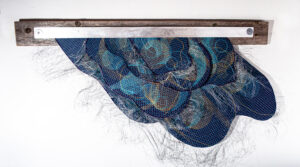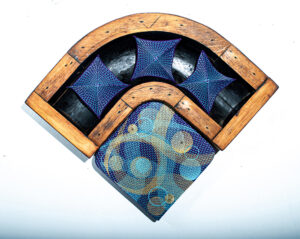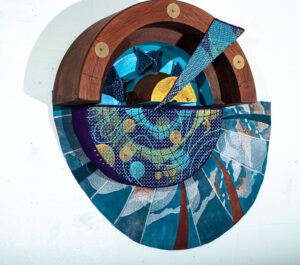“Can Beauty Help Us?” by Susan Hensel
August 12, 2022
I make art to learn and understand what I am thinking and feeling. While it is always an internal investigation, I am engaged with the world and culture around me. There is much to horrify me: violence at home and abroad, global climate crisis, racism, rapacious capitalism and more. In response, I began to collect quotes, thoughts and questions on beauty in an attempt to further understand the relationship between my work and the world around me. Below are the beginning stages of this manifesto or compendium that I’m working through.

Susan Hensel, Atmospheric River, 2021. Polyester felt, embroidery thread, aluminum screen, barn wood, brushed aluminum, hardware, Heat Bond adhesive, digitally embroidered, 22 x 40 x 4 inches. Photo by the artist.
Does activism need to be strident? Or, can it bend toward beauty?
There are many questions I ask myself in the studio:
- Should I create artwork showing the violence I abhor when I am a pacifist?
- Do I depict the destruction of the rainforests when I want them protected?
- Can I show you cruel feedlots when I want to encourage ethical farming techniques?
- How can I depict police violence when a different outcome is what I work for?
- How can my artwork reflect my concerns and remain true to my belief system?
I am a quiet, contemplative, delayed emotional reactor, and a visual glutton. I think, I meditate, I pray, I get angry the next day and I just simply must look…all the time. From this essential dispositionI have adopted a theory for my art making that I refer to as Radical Beauty.

Susan Hensel, Firmament, 2022. Polyester felt, embroidery thread, pink insulation board, foundry mould, acrylic paint, adhesives, hardware, digitally embroidered, assemblage, 21 x 26 x 4 inches. Photo by the artist.
Thoughts on the political nature of beauty:
- Late critic, David Hickey: “[Beauty is] the pleasure we take in something that transcends the appropriate.” (“The Invisible Dragon,” pg 69, chicago press 2009)
- Irish poet and priest, John O’Donahue: “Even amidst chaos and disorder, something in the human mind continues to seek beauty.” (“Beauty,” pg 23, Harper Collins 2004)
Radical beauty is not about pretty décor nor reproducing lush landscapes or beautiful faces any more than civility is about serving cookies and being nice. It is tougher than that. Civility involves hard conversations around differences that do not attack the personhood or the people in the conversation. Civility is a tough form of hospitality that welcomes difference, acknowledges individuality, and tries to find commonalities.

Susan Hensel, NOAA, 2022. Polyester felt, embroidery thread, muslin, Procion dyes, metal leaf, brass screen, map pins, acrylic paint, foundry mould, fusible pellon, digitally embroidered, assemblage, 16 x 20 x 6 inches. Photo by the artist.
Radical beauty is similar. It takes the stance that if we can produce beauty around the issues that bother us the most, then we might be able to create the world we want to see. Beauty can be produced around the issues that bother us the most, then we might be able to create the world we want to see. That is essentially political. I maintain that as artists, we are able to create glimpses of the world we want to see, providing moments of awe, meditation, and surprise that might invite the viewer into action for healing of the planet, relationships, cultures, and our environments.
For me this is expressed in the lush beauty of the Neotectonic Period series I have been working on for the past year. It is the core part of a show I developed that has begun to travel: Bending Toward Beauty. The exhibition started as an online exclusive with Envision Magazine; moved onto Artsy.net, and went to the Benedictine Monastery of St. Paul. It will soon go to the Hopkins Arts Center and the Duluth Art Institute in late 2022.

Susan Hensel, Run-Off Model, 2022. Polyester felt, embroidery thread, Foundry mould, foam core, plywood, adhesives, digitally embroidered, assemblage, 19 x 12 x 3. Photo by the artist.
Neotectonics is the study of the motions and deformations of the earth’s crust in current or recent geologic time (Neotectonics by James P. McCalpin, 2013). It struck me as an apt metaphor for these times of upheaval. In particular, for dealing with the evidence of the climate crisis, here in Minnesota. Our weather is wild, boomerang weather, dropping or rising 60 degrees in a day. The pendulum swings from drought to flood and back to drought gain. Clouds pour into this once sunny state. This is the zone I work in. I am upset with the accelerating changes I experience. But I am called to the slow, quiet surprise of beauty. I want to provide for people a moment of repose, of reverie, where they can feel again: feel the beauty that remains; feel the repairs that are possible.
I contend that we all know that the world is mighty broken. But, I do not need to see reproductions of devastation by even the most talented of artists to be reminded of these facts. I’m not saying that these devastating artworks should not be made—surely they must be made. I am saying that I will not make violent artworks. Those emotions do pour out into my journals and my sketchbooks.

Susan Hensel, Solar Tides, 2022. Polyester felt, embroidery thread, cotton batting, stretchers, adhesives, digitally embroidered, 22 x 26 x 2. Photo by the artist.
The facts are all around us: The weather is wild, wars rage, politics are more divisive than ever. Anger, threats, and suspicion reign and the capacity for hate rises.We cannot ignore the destructive actions all around. But I contend that we artists have multiple ways to address these things. One way is to provide opportunities for beautiful encounters, awe struck encounters, on these very topics, then we can be reminded of what we seek: peace, health, and abundance.
So, I will, as a political and aesthetic act, put radical beauty into the world. It’s a stretch and it’s a slow, healing process.
–Susan Hensel received her BFA from University of Michigan in 1972. She is known for her artists books and her innovative fiber sculpture. Hensel’s artwork is known and collected nationwide, represented in collections as disparate as the Museum of Modern Art in New York and Duke University Special Collections. susanhenselprojects.com
